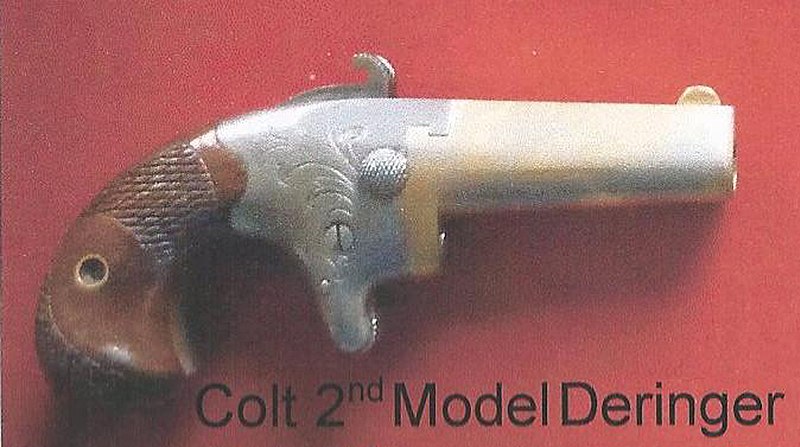The original Philadelphia Deringer was a muzzleloading caplock single-shot pistol introduced in 1825 by Henry Deringer. They were single barrel pistols with back-action percussion locks, typically .41 caliber with rifled bores, and wood stocks.
The term “derringer” became a general misspelling during the reporting of the Lincoln assassination, which was committed with a Philadelphia Deringer. Copies are made world wide and sold with the ‘Derringer’ appellation. Modern derringers use metallic cartridges and vary in design from 1 barrel, 2 barrel or 4 barrel. Overall length is usually considerably less then 6 inches.

Colt Derringers were an early import to Britain from America. There are several ‘Types’ or models that Colt has produced (and in some cases still produces.)


Numerous companies produce multi shot derringers, copies of the Remington (above) or the Sharps are very common. Four barrel derringers are sometimes referred to as ‘Pepper Boxes.’

The Remington Elliot came in 4 and 5 shot versions. These were also widely copied.


Weapon Name/Type: This will include the manufacturer if the weapon is made by a major company. Surplus weapons will indicate the Nation that had the gun manufactured. Military weapons are often contracted through multiple manufacturers and are built to the military’s specifications
It has been 30 years since any company or government produced cap and ball firearms. Most of those that were cap and ball have been converted to cartridge firing weapons. If a model appears here it was either built to fire cartridges or was converted to fire cartridges.
Caliber: (Cal) The Caliber of the weapon. See ammunition chart for damage.
Rate of Fire: (RoF) The number of times the weapon can be fired in a Combat Round. Note: Repeaters can be fired up to 4 times and revolvers 6 times per Combat Round.
Number of Shots: (# of Shots)The number of times the weapon can be fired before reloading is required.
Condition and Reliability: (C&R) Name brand weapons are more expensive then ‘knockoffs’ and copies, however the likely hood of a serious malfunction on a roll of 1 is less for these guns. New guns are very reliable. Used, less so, Much depends on past care and usage. Of particular note is the weapon’s ability to handle the higher pressures of modern smokeless powder. Many of the older and cheaper guns are unable to safely and reliably handle the higher pressures resulting from the new propellants, though quality weapons are largely unaffected. Older guns firing smokeless have a 1 in 6 chance of exploding anytime a natural 1 is rolled on the d20. The following scale reflects the guns Reliability and Condition. This ALSO impacts the weapon’s retail price.
| Rating | Description |
| 1 | Brand New, modern design, from a name manufacturer. Accuracy is excellent +1, Reliability is very high, +2. Can handle Smokeless Powder easily. Full price retail. |
| 2 | Lightly Used and in Good Condition from a name manufacturer or a quality copy. The design and style may be slightly dated but still current. Accuracy is good 0, Reliability is high +1. Can handle Smokeless Powder but Black Powder is better for it. 75% of original price retail. |
| 3 | Well Used name brand, or lightly used or new from a manufacturer of unknown or dubious quality. Or out dated but functional. Accuracy is fair, -1 Reliability is fair, 0 Most Military Surplus falls in this category. Smokeless Powder MAY damage the weapon. 50% to 30% of original price retail. |
| 4 | Heavily Used and/or, Very Obsolete. Smokeless Powder LIKELY to damage the weapon. Accuracy is poor, -2 Reliability is poor -2 25% of original price retail. |
| 5 | Worn Out. The gun has been ‘shot out.’ Smokeless Powder? DON’T! Rifling is worn out, Accuracy is terrible -3 Mechanisms are rattly and prone to jam or fail, Reliability is -3. 10% of original price retail. |
| 6 | Suitable for parts, maybe… Club, paperweight or wall ornament. Smokeless Powder? LOL! Pay?? |
Concealability: (Con) Concealment reflects the ability to walk down the street wearing a sidearm, under a coat, sweater, shawl, cloak, etc without it being noticed by an observer. The weapon’s Concealability Number is added to the observer’s IQ roll to see if he notices the gun. The average citizen is not looking to see if passersby are carrying a weapon, so the need to make the roll is unlikely. Police Officers, Private Detectives, Criminals, ‘Adventurers’ and other nefarious types do have an eye for such things. Of course, on a busy street they can’t be looking everyone over, so unless something draws their eye, there is only a 1 in 6 chance that the Copper will even look someone over! At that point they roll against their Intelligence with adjustments per the weapon and type of carry arrangement.
Weight: (Wt) in pounds or fractions of pounds
Price: Largely a reflection of Condition and Manufacturer. Name brands cost more!
Notes: Specifics related to the weapon are listed here. Some weapons have more extensive descriptions and notes, these are marked with a *

